Pentax V-323N, V-325, V-335N, V-325N INSTRUCTION MANUAL
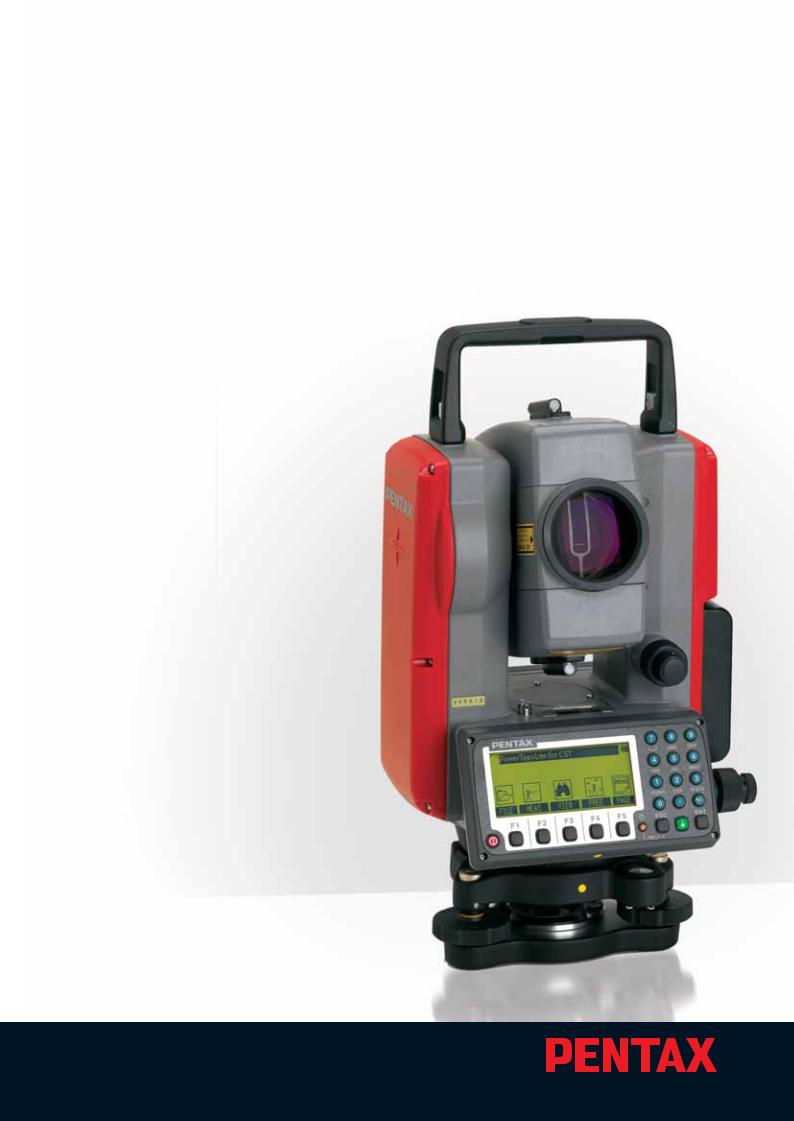
TOTAL STATION
V-300SERIES
V-325 | V-325N | V-335N | V-323N
INSTRUCTION
MANUAL
V-300 SERIES
Basic Procedures
PENTAX Industrial Instruments Co., Ltd.
2-36-9, Maeno-cho
Itabashi-ku, Tokyo 174-0063 Japan Tel. +81 3 3960 0502
Fax +81 3 3960 0509
E-mail: international@piic.pentax.co.jp Website: www.pentaxsurveying.com
CONTENTS
General |
|
|
Precautions regarding safety |
4 |
|
Warning |
4 |
|
Usage Precautions |
6 |
|
|
|
|
1 Basic Operation |
8 |
|
1.1 |
Names of parts |
8 |
1.2 |
Unpacking and packing |
9 |
1.3 |
Standard equipment |
10 |
1.4 |
How to charge the battery |
10 |
|
|
|
2 Display and Keyboard |
12 |
|
2.1 |
Display and keyboard |
12 |
2.2 |
Operation key |
12 |
2.3 |
Function Key |
13 |
2.4 |
Alphanumeric input |
15 |
2.5 |
Laser pointer |
15 |
|
|
|
3 Preparation for Surveying |
16 |
|
3.1 |
Centring and Levelling of the Instrument |
16 |
3.2 |
Optical plummet |
16 |
3.3 |
Levelling with circular vial |
17 |
3.4 |
Levelling with the plate vial |
17 |
3.5 |
Eyepiece adjustment |
17 |
3.6 |
Target sighting |
18 |
3.7 |
Attachment and detachment of tribrach |
19 |
|
|
|
4 Turning the Power On |
20 |
|
4.1 |
Turning the power on and off |
20 |
4.2 |
Adjusting LCD contrast |
20 |
4.3 |
Adjusting illumination brightness |
21 |
4.4 |
Adjusting reticle illumination |
21 |
|
|
|
5 Angle Measurement |
22 |
|
5.1 |
Measuring an angle |
22 |
5.2 |
Resetting the horizontal angle to 0 |
22 |
5.3 |
Holding the horizontal angle |
23 |
5.4 |
Inputting an arbitrary horizontal angle |
23 |
5.5 |
Displaying the % slope of the vertical angle |
24 |
5.6 |
Changing the horizontal angle from clockwise to counterclockwise |
25 |
|
|
|
6 Distance Measurement |
26 |
|
6.1 |
Target setting |
26 |
6.2 |
Distance measurement |
27 |
6.3 |
Quick Mode |
28 |
>>
2
CONTENTS
>>
7 Correction Mode |
28 |
7.1 Changing the target constant |
28 |
7.2 Changing the temperature |
29 |
7.3 Changing the atmospheric pressure |
30 |
7.4 Changing the ppm value |
31 |
8 Initial Setting |
33 |
|
8.1 |
Overview |
33 |
8.2 |
Entering the mode for initial setting 1 |
33 |
8.3 |
Entering the mode for initial setting 2 |
33 |
8.4 |
Entering the mode for initial setting 4 |
34 |
8.5 |
Entering the mode for initial setting 5 |
34 |
8.6 |
Example of changing an initial setting content |
35 |
|
(selection of atmospheric correction) |
|
8.7 |
Initial setting 1 |
35 |
8.8 |
Initial setting 2 |
36 |
8.9 |
Initial setting 4 |
38 |
8.10 |
Initial setting 5 |
38 |
9 Accessing the Functions |
40 |
|
9.1 |
Accessing by help key |
40 |
9.2 |
Accessing by 007 |
40 |
|
|
|
10 Data Collector |
41 |
|
|
|
|
11 Checks and Ajustments |
41 |
|
11.1 |
Plate Level |
41 |
11.2 |
Circular Vial |
42 |
11.3 |
Vertical reticle |
42 |
11.4 |
Perpendicularity of line of sight to horizontal axis |
43 |
11.5 |
Vertical 0 point error |
44 |
11.6 |
Optical plummet |
44 |
11.7 |
Offset constant |
45 |
11.8 |
The EDM beam axis |
45 |
|
|
|
12 Appendix |
46 |
|
12.1 |
Warning and Error Messages |
46 |
12.2 |
Atmospheric Correction |
47 |
12.3 |
Calculation Formula |
47 |
12.4 |
Distance Range |
49 |
12.5 |
Specifications |
50 |
12.6 |
Notice to the user of this product |
51 |
12.7 |
Labelling |
52 |
3

PRECAUTIONS REGARDING SAFETY
Safety precautions (Must be followed)
The following items are intended to prevent possible injury to the user or other people and/or damage to the instrument before it occurs. These safety precautions are important to the safe operation of this product and should be observed at all times.
Distinctive displays
The following displays are used to distinguish precautions by the degree of injury or damage that may result if the precaution is ignored.
WARNING
Items indicated by this sign are precautions which, if ignored, would result in serious injury.
CAUTION
Items indicated by this sign are precautions which if ignored may result in injury or material damage.
•Here “injury” refers to injuries such as cuts, burns or electric shock the treatment of which will not likely require hospitalization or long-term attention.
•“Material damage” refers to damage to facilities, buildings, acquired data, etc.
Before using this product, be sure that you have thoroughly read and understood this instruction manual to ensure proper operation. After reading this manual, be sure to keep it in a convenient place for easy reference.
This instrument complies with the protection requirement for residential and commercial areas. If this instrument is used close to industrial areas or transmitters, the equipment can be influenced by electromagnetic fields.
Quick Reference Guide provided in your carrying case contains the following items:
1.Basic Procedures,
2.Power Topo Express Operating Procedures
WARNING
 Do not stare into the laser beam directly as this may result in damage to your eyes.
Do not stare into the laser beam directly as this may result in damage to your eyes.
 V-300 is a Class II Laser product.Do not look into the laser radiation aperture directly as
V-300 is a Class II Laser product.Do not look into the laser radiation aperture directly as
this may result in damage to your eyes.(The reflectorless type is a Class IIIa (3R) laser product.)
 Never use the telescope to view intense light such as direct sunlight or sunlight reflected through a prism as this may result in loss of sight.
Never use the telescope to view intense light such as direct sunlight or sunlight reflected through a prism as this may result in loss of sight.
 Do not disassemble, modify or repair this product as there a risk of laser radiation.
Do not disassemble, modify or repair this product as there a risk of laser radiation.
 Do not aim the laser beam at a person as it is harmful to the eyes and body. Receive the examination treatment by the doctor when the eyesight or body trouble is doubted by any chance.
Do not aim the laser beam at a person as it is harmful to the eyes and body. Receive the examination treatment by the doctor when the eyesight or body trouble is doubted by any chance.
•Electro-Magnetic Compatibility (EMC):
This instrument complies with the protection requirement for residential and commercial areas. If this instrument is used close to industrial areas or transmitters, the equipment can be influenced by electromagnetic fields.
•Do not use this product in a coal mine, in a location where there is coal dust, or near flammable material as there is a risk of explosion.
•Do not disassemble, modify or repair this product as there is a risk of fire, electric shock and burn injury. If you think the product requires repair, contact the retail outlet where you purchased it or an authorized repair site.
•Do not charge BP02 Battery with any battery charger other than BC03 as it entails a risk of
4

fire or burn injury from the battery bursting into flames due to possible differences in voltage or polarity.
•Do not use a damaged electric cord plug or loose electric outlet when charging as there is a risk of fire or electric shock.
•Do not charge the battery while covered by clothes or similar item as there is a risk of fire if the clothes ignite.
•Do not use the battery or charger when wet as there is a risk of fire and burn injury due to short-circuit.
•To prevent making short-circuit when removing the battery and charger from the case and storing them, apply electrically resistant tape to the poles of the battery. Storing the battery and charger as it may result in fire or burn injury due to short-circuit.
•Do not throw the battery into fire or expose it to heat as there is a risk of injury if it explodes.
CAUTION
 For your safety, perform the initial and periodical inspection as well as when the instrument is fixed and adjusted.
For your safety, perform the initial and periodical inspection as well as when the instrument is fixed and adjusted.
 When the laser beam enters eyes, an unexpected accident might be caused by blink of eyes.
When the laser beam enters eyes, an unexpected accident might be caused by blink of eyes.
 Do not place the laser product at a height where its laser beam may hit the eyes of car drivers and pedestrians.
Do not place the laser product at a height where its laser beam may hit the eyes of car drivers and pedestrians.
 Do not place the laser product at a place where its laser beam may hit a reflecting object such as a mirror or a glass window. The refection beam of the laser is also harmful to the human body.
Do not place the laser product at a place where its laser beam may hit a reflecting object such as a mirror or a glass window. The refection beam of the laser is also harmful to the human body.
 When not performing measurement, cut off the power supply or shade the Objective lens with Objective cap to prevent the instrument emitting the laser beam.
When not performing measurement, cut off the power supply or shade the Objective lens with Objective cap to prevent the instrument emitting the laser beam.
 Keep the laser product in a place where persons who do not have the product knowledge, such as children, can not touch it by mistake.
Keep the laser product in a place where persons who do not have the product knowledge, such as children, can not touch it by mistake.
•Before disposing of the instrument, destroy its power supply mechanism to prevent it from emitting the laser beam.
•Do not remove the handgrip without good reason. If it does come off, be sure to attach it securely to the instrument with screws. If it is not fastened securely, the instrument may fall when you use the handgrip, leading to possible injury.
•Do not short the poles of the battery or charger as there is a risk of injury or fire.
•Do not touch any fluid which may leak from the battery as there is a risk of chemical burn injury or reaction.
•Do not insert or remove the electric plug with wet hands as there is a risk of electric shock.
•Do not use the case to stand on as it is slippery and unstable and may cause you to fall, resulting in possible injury.
•Be sure the tripod itself and the instrument on the tripod are both installed securely as insecure installation may cause the tripod to fall over or the instrument to drop, resulting in possible injury.
•Do not carry the tripod with the metal shoe pointing toward another person as it may injure him/her.
•The instrument contains a rechargeable battery and a battery charger.
•It may be illegal to dispose the battery at the end of its useful life.
•Check with your local solid waste officials for details for recycling.
5

Usage precautions
Surveying instruments are high-precision instruments. In order to assure that the Electronic Total Station V-300 series product which you have purchased will provide long-lasting maximum performance, the precautions in this manual must be followed. Be sure to follow these instructions and use this product properly at all times.
[Solar observation]
WARNING
Never view the sun directly using the telescope as this may result in loss of sight.
Never point the objective lens directly at the sun as this may damage internal components. When using the instrument for solar observation, be sure to attach the specially designed solar filter (MU64) to the objective lens.
 [Laser beam]
[Laser beam]
Do not stare into the laser beam. V-300 is a class-II Laser product. (The reflectorless type is a Class IIIa (3R) laser product.)
[EDM axis]
The V-300 series EDM is the red visible laser beam and the beam diameter is very small.
The beam is emitted from the objective centre. The EDM axis is designed to coincide with the telescope sight axis (but both axes may deviate slightly because of intense temperature changes and a long time lapse).
[Target constant]
Confirm the Target Constant of the instrument before measurement.
If a different constant is to be used, use the correct constant of the target. The constant is stored in the instrument's memory when turned off.
[Reflectorless and reflector sheet]
•Reflectorless
The measurement range and accuracy of the Reflectorless mode are based on the condition that laser beam is emitted perpendicular to the white side of a Kodak Gray Card.
The measurement range may be influenced by the shape of the target and its environment. There is a possibility that the range may vary when the target does not satisfy the conditions above at survey work.
•There is a possibility that correct distance measurement may not be performed by dispersion or reduction of laser beam when the laser beam comes into the target from a diagonal angle.
•There is a possibility that the instrument may not be able to correctly calculate out the distance when receiving reflected laser beam from forth and back directions in case of measuring the target on the road.
•There is a possibility that synthesized values are calculated and the distance may become longer or shorter than the actual one when the operator measures the target of slope or sphere or rugged shape.
•There is a possibility that the instrument may not be able to correctly calculate out the distance by collecting the reflected laser beam from a man or a car that comes and goes in front of the target.
•There is a possibility that the distance may not be correctly measured when measuring a target in the direction where there is a reflecting object (mirror, stainless board and white wall, etc.) or under too strong sun light.
•In a situation high accuracy may not be expected, perform the measurement by Reflector sheet or Prism.
•When using reflector sheet, set the reflector sheet to have its surface be approx. vertical to the aiming line. If it is positioned not to be approx. right angle, there is a possibility that correct distance measurements may be impossible by dispersion or reduction of laser beam.
6
In the following environments, the distance might not be able to be measured.
There is a reflection things (mirror, stainless board and white wall, etc.) in the direction of the target and under too strong sun light
[Battery & charger]
•Do not use any battery or battery charger that is not approved by Pentax as it entails a risk of damaging the instrument.
•If water should happen to splash on the instrument or the battery, wipe it off immediately and allow it to dry in a dry location. Do not put the instrument in the case until it is completely dry as this may result in damage to the instrument.
•Turn off the power when removing the battery from the instrument as removing the battery while the power is still on may result in damage to the instrument.
•The battery mark displayed on the instrument is only an estimation of remaining battery power and is not completely accurate. Replace the battery quickly when it is about to run out of power as the time a battery lasts on one full charge differs depending on conditions of ambient temperature, and the measurement mode of the instrument.
•Confirm the battery level remaining before operating.
[Storage and operating environment]
•To prevent making short-circuit when removing the battery and charger from the case and storing them, apply electrically resistant tape to the poles of the battery. Storing the battery and charger as it may result in fire or burn injury due to short-circuit.
•Avoid storing the instrument in places subject to extreme high, low or radically fluctuating temperature. (Ambient temperature range during use: –20° C to +50° C)
•Distance measurements may take longer when atmospheric conditions are poor such as when heat shimmer occurs. When storing the instrument, always put it in its case and avoid storage in dusty location or location subject to vibration or extreme heat or humidity.
•Whenever there is a sharp temperature difference between the instrument’s storage and usage environment, allow the instrument to adjust to the environment for an hour or more before using it. Be sure to protect the instrument from the sun if the location is subject to intense direct sunlight.
•During surveys for which the survey precision or atmospheric measurement method has been defined, measure the atmospheric temperature and pressure separately and enter those values.
•The battery should be charged approximately once per month if the instrument is to be stored for an extended period of time. The instrument should also be removed from its case occasionally and aired out.
•In addition to these precautions, be sure to handle the instrument properly at all times follo wing the descriptions given in the various sections of this manual to assure safe and proper measurements.
[Transporting and carrying the instrument]
•Be careful to protect this instrument from shock of impact and excessive vibration which may result in damage during transportation and shipment.
•When transporting the instrument, always put it in the case and wrap shock absorbing material around it and be sure it is handled as “FRAGILE”.
[Checks and repairs]
•Always check the instrument before beginning work and check that the instrument is maintaining the proper level of precision. Pentax bears absolutely no responsibility for damages due to survey results obtained from surveys conducted without an initial instrument check.
•Never disassemble the instrument, battery or charger, even if you do detect an abnormality, as there is a risk of fire or electric shock due to short-circuit. If you think the product requires repair, contact the retail outlet where you purchased it or an authorized repair site.
7
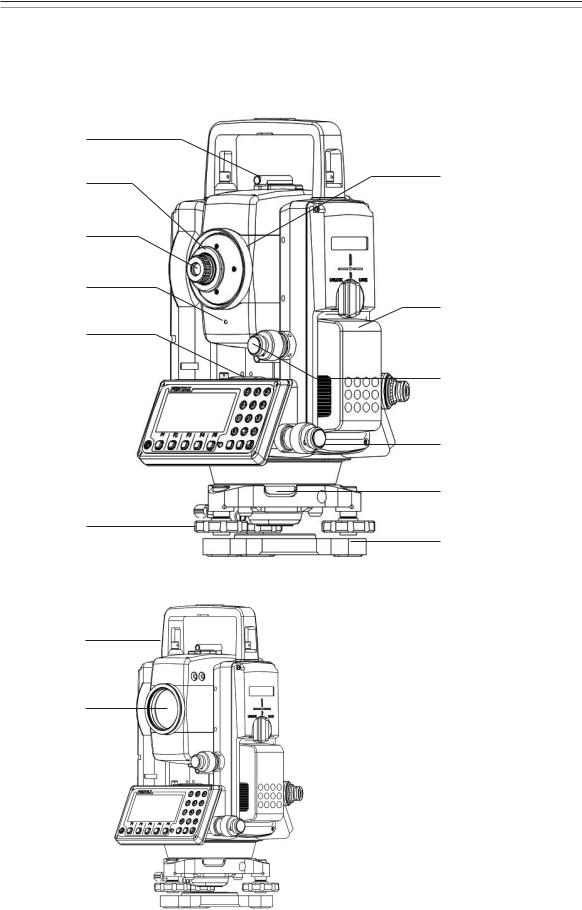
1. BASIC OPERATION
1.1 Names of parts
Collimator
Eyepiece ring
Eyepiece
Laser indicator
Plate level
Display panel 
Key board 
Circular vial 
Leveling screw
Top handle
Objective lens
Focus ring
 Instrument height mark
Instrument height mark
 Battery latch
Battery latch
Battery pack
 Telescope tangent screw
Telescope tangent screw
Telescope clamp screw
 Tangent screw
Tangent screw
Clamp screw
Detaching knob
Base plate
8
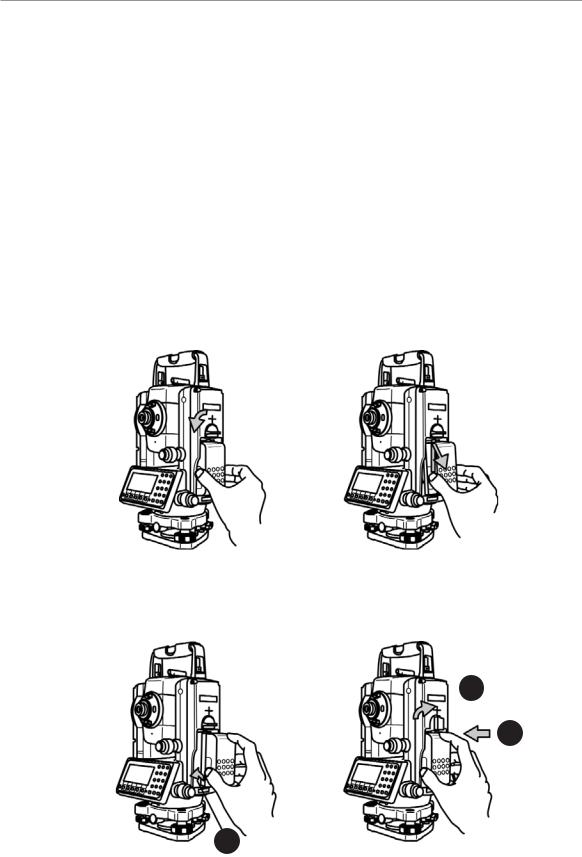
1.2 Unpacking and packing
[Unpacking the Instrument from the case]
Set the case down gently with the lid facing upwards.
Open the latches while pressing down on the lock (safety mechanism) and open the lid of the case.
Remove the instrument from the case.
[Packing the instrument in the case]
Make sure the telescope is fairly levelled and lightly tighten the telescope clamp screw.
Line up the housing marks (round yellow marks on the instrument) and tighten the upper and lower clamp screws.
With the housing marks are facing upward, set the instrument gently in the case without forcing it. Close the lid to the case and secure the latches.
1. Basic Operation
1.1 Removing the Battery
1 |
|
2 |
|
|
|
(1)Rotate the knob above the battery pack counterclockwise.
(2)Lift up the battery pack and remove it from the instrument.
1.2 Attaching the Battery
2
1
1
(1)Place the channel on the bottom of the battery pack, onto the protrusion of the instrument and push the battery pack down into place.
(2)Turn the knob clockwise.
9

1.3Standard equipment
•Instrument
•Carrying case
•Battery
•Charger
•Plumb bob
•Hexagonal wrench
•Rain cover
•Quick Reference Guide
•CD
1.4How to charge the battery
[Charging the battery]
•The battery BP02 is not charged at our factory shipment. It must be changed before use.
•For BP02 charge, use the special BC03 charger.
[Connection of code]
(1)Insert the output plug of the power supply code in Jack of the AC adaptor.
(2)Insert the output plug of the AC adaptor in Jack of the charger.
(3)Insert the power supply plug of the power supply code in the outlet of AC power supply.
[Installation of battery]
(1)Draw the battery to the lock lever side and put it on the battery pocket. The battery is firmly installed on the battery pocket.
(2)Press down the battery and then slide it to the opposite direction of the lock lever.
(3)The lock lever goes up, and the battery is fixed.
(4)Under such a condition, if “Connection of the code” is done, the charge with the battery is begun.
[Detaching the battery]
(1)Press the lock lever and slide the battery to the lock lever direction.
(2)Detach the battery packing from the battery pocket.
10

[Display panel]
(1)Power supply lamp (red) : Turns on when the power supply is turned on.
(2)Charge lamp (green) : Turns on while charging and turns off when the charge is
completed.
(3) Discharge lamp (yellow) : Turns on when you push the discharge button. Turns off when the discharge is completed.
(4) Installation lamp (red) : Blinks or turns on when the battery packing is attached normally. Blinks when charge or discharge and turns on when charge is completed.
(The charge lamp in the lower does not blink and does not turns on)
(5) Discharge button : Discharge lamp lights when you push this button, and the discharge of battery begins.
[How to charge]
(1)It begins charging automatically when you set the battery packing in the charger which beams the power supply lamp.
(2)Leave just as it is until the charge is completed.
(3)When the charge is completed, the charge lamp is turned off.
(4)Detach the battery packing from the charger when the charge is completed.
[Refreshing the battery]
The use time shortens gradually by the phenomenon of “Effect of the memory” when the NiMH battery leaves capacity and repeats the charge. The voltage recovers after refreshing and the use time returns normally in such a battery. Please refresh one degree every five times of the charge.
[Refreshing]
Set the battery in the charger as well as the case of the charge. Push the electrical discharge button. The electrical discharge lamp lights and the electrical discharge begins.
The electrical discharge lamp is turned off when the electrical discharge ends, the charge lamp lights, and the charge starts automatically. Leave just as it is until the charge is completed. When the charge is completed, the charge lamp is turned off. Detach the battery from the charger.
[Time of refreshing and charge]
Battery BP02 is discharged from the state of a full charge at about 960 minutes and the charge is completed from the electrical discharge at about 130 minutes. However, the electrical discharge time is proportional to the remainder capacity of the battery. Moreover, the time required for refreshing might be different from the above-mentioned time according to a surrounding temperature and the state of the battery.
11
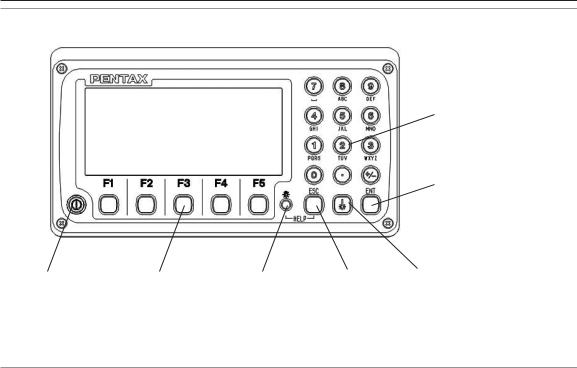
2. DISPLAY AND KEYBOARD
2.1 Display and keyboard
Alphanumeric and +/- key
Enter key
Power supply key |
Function key |
Illumination key |
ESC key |
Laser key |
2.2 Operation key
Key |
Description |
[POWER] |
ON/OFF of power supply |
[ESC] |
Returns to previous screen or cancels an operation. |
[ILLU] |
Turns the illumination of the LCD display and telescope reticle on |
|
and off. |
[ENT] |
Accepts the selected (highlighted) choice or the displayed screen |
|
value. |
[LASER] |
ON/OFF of laser |
[Alphanumeric] |
At the numerical value screen, the numerical value and the sign “.” |
|
displayed are input. The English characters printed right under |
|
numeric of each key are input. |
[HELP] |
Pressing [lLLU]+[ESC] key causes a help menu to appear in |
|
A MODE or B MODE or causes a help message to appear. |
12

2.3 Function Key
Display F. Key |
Description |
|
MODE A |
|
|
[MEAS] |
F1 |
Pressing this key one time measures the distance in |
|
|
normal mode another measurement type can be selected |
|
|
by Initial Setting 2. Pressing this key twice measures the |
|
|
distance in coarse mode another measurement type can |
|
|
be selected by Initial Setting 2. |
[TARGET] |
F2 |
[V-325]: |
|
|
Switches the target between SHEET/PRISM. |
|
|
[V-325N, V-335N, V-323N]: |
|
|
Switches the target between SHEET/PRISM/REFLECTORLESS. |
[0 SET] |
F3 |
Resets the horizontal angle to 0° 0’ 0” by pressing twice. |
[DISP] |
F4 |
Switches the display composition in the order |
|
|
“H.angle/H.dst./V.dst.”, “H.angle/V.angle/S.dst.” and |
|
|
“H.angle/V.angle/H.dst./S.dst./V.dst.” |
[MODE] |
F5 |
Switches the screen between MODE A and MODE B. |
MODE B |
|
|
[S.FUNC] |
F1 |
PowerTopoLite Special Functions |
[ANG SET] |
F2 |
Brings up the angle setting screen for setting angle-related |
|
|
parameters |
|
|
(H.ANGLE/%GRADE, H.ANGLE INPUT and R/L REVERSE). |
[HOLD] |
F3 |
Pressing this key twice retains (holds) the horizontal angle |
|
|
shown on the display. |
[CORR] |
F4 |
Brings up the screen for changing the target constant, |
|
|
temperature. |
|
|
Pressure setting. |
[MODE] |
F5 |
Switches the screen between MODE A and MODE B. |
13

Other functions
[ |
] |
F1 |
Moves the cursor to the left. |
[ |
] |
F2 |
Moves the cursor to the right. |
[ |
] |
F1 |
Goes back five items on the screen. |
[ |
] |
F2 |
Goes forward five items on the screen. |
[ |
] |
F3 |
Moves the cursor up. |
[ |
] |
F4 |
Moves the cursor down. |
[RETICLE] |
F3 |
Changing the reticle illumination when pressing |
|
|
|
|
illumination key. |
[LCD] |
F4 |
Changing the LCD contrast when pressing illumination key. |
|
[ILLU] |
F5 |
Changing the LCD illumination when pressing |
|
|
|
|
illumination key. |
[CLEAR] |
F5 |
Clear the figure. |
|
[SELECT] |
F5 |
Open the selection window. |
|
|
|
|
|
[How to move the menu number] Example:
The cursor is located at Menu 1.
Press the numeric key 0 and 2 to move to Menu 2 or press [F4] [  ].
].
ANGLE SET
1.ANGLE / %GRADE: ANGLE
2.H.ANGLE INPUT: 092 30’ 20”
3.R/L REVERSE: RIGHT
SELECT
ANGLE SET
1.ANGLE / %GRADE:ANGLE
2.H.ANGLE INPUT: 092 30’ 20”
3.R/L REVERSE: RIGHT
SELECT
14

2.4 Alphanumeric input
The point name is inputted by the alphanumeric keys as following.
Key |
Letter under key |
Letter & figure order to input |
[0] |
|
[@][.][_][-][:][/][0] |
[1] |
PQRS |
[P][Q][R][S][p][q][r][s][1] |
[2] |
TUV |
[T][U][V][t][u][v][2] |
[3] |
WXYZ |
[W][X][Y][Z][w][x][y][z][3] |
[4] |
GHI |
[G][H][I][g][h][i][4] |
[5] |
JKL |
[J][K][L][j][k][l][5] |
[6] |
MNO |
[M][N][O][m][n][o][6] |
[7] |
|
_ |
|
[ ] [?] [!] [_] [ ] [ ~] [ | ] [&] [7] |
|
[8] |
ABC |
[A][B][C][a][b][c][8] |
[9] |
DEF |
[D][E][F][d][e][f][9] |
[.] |
|
[.][,][:][;][#][(][)] |
[+/-] |
|
[+][-][*][/][%][=][<][>] |
|
|
|
2.5 Laser pointer
The Laser pointer function turns the laser beam on continuously to become the aiming point so that visual confirmation is possible.
1When the [Laser] key is pressed, the Laser pointerfunction is turned on.
The Laser indicator is turned on and the “ ” mark on the left of the screen blinks while the Laser pointer function is operating.
” mark on the left of the screen blinks while the Laser pointer function is operating.
2If the [Laser] key is pressed while the Laser pointer function is operating, the Laser pointer function is turned off.
•The beam of the sun is strong and visual confirmation is difficult in daytime when out doors.
•The laser beam is designed not to be able to observe through the telescope.
•Please visually align the laser beam to the target and mark the center.
Confirm the alignment (horizontal and vertical ) before measuring when performing accurate work like stake out when using the Laser pointer function.
Also refer to 11.8 The EDM beam axis.
•Please do not look at the laser source of beam directly.
15
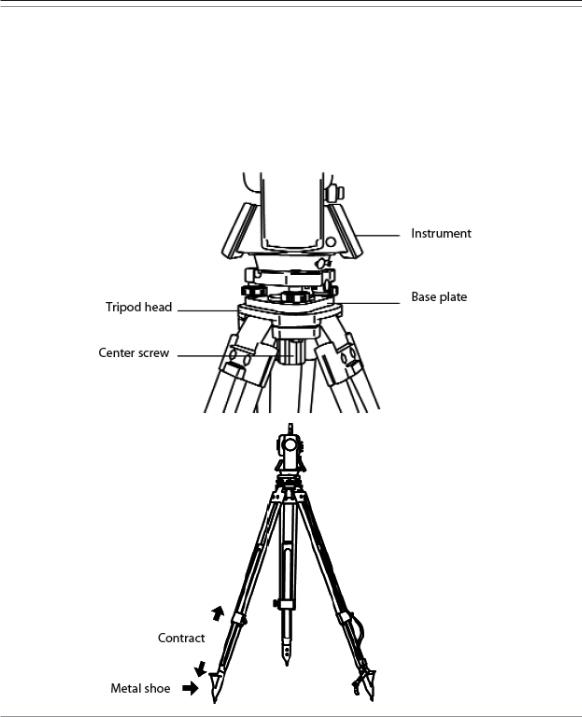
3. PREPARATION FOR SURVEYING
3.1 Centring and levelling of the instrument
[Setting up the instrument and the tripod]
Adjust the tripod legs so that a height suitable for observation is obtained when the instrument is set on the tripod.
Hang the plumb bob on the hook of the tripod, and coarse centre over the station on the ground. At this time, set the tripod and fix the metal shoes firmly into the ground so that the tripod head is as levelled as possible. If the tripod head is mis-leveled by the action of fixing the metal shoes into the ground, correct the level by extending or retracting each leg of the tripod.
3.2 Optical plummet
Look through the optical plummet eyepiece, and rotate the eyepiece knob until the centre mark can be seen clearly.
Rotate the focusing knob of the optical plummet and adjust the focus on the ground mark. Loosen the centring clamp screw and push the upper plate by finger and stay the centre mark on the ground mark.
Tighten the centring clamp screw.
Loosen the horizontal clamp screw and rotate the instrument every 90° and confirm the Circular vial is centred correctly. If the bubble is not centred, it can be properly set using the levelling screws.
16
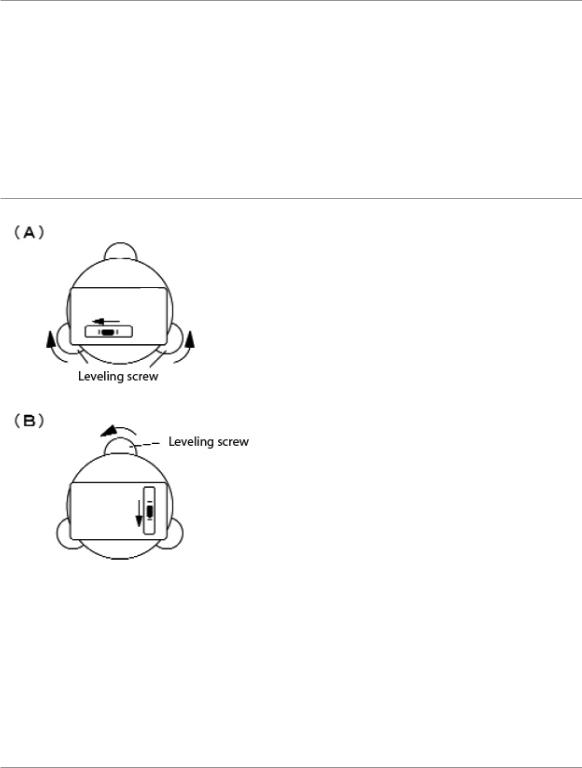
3.3 Levelling with circular vial
Tripod is adjusted according to the following points by extending or contracting the legs so that the bubble of the Circular vial goes to the centre of the circle.
•Shorten the leg at the side of the bubble or extend the leg opposite of the bubble to position the bubble in the centre of the vial circle.
•All three legs are extended or contracted until the bubble is in the centre.
During this process, the foot is not placed on the tripod leg point and the position of the tripod points do not change.
3.4 Levelling with the plate vial
-(A) Align the plate vial in parallel with a line joining any two of the levelling screws. Then, adjust the two screws to centre the bubble in the plate vial.
-Turn two levelling screws in an opposite direction mutually in a way that the bubble moves from the side of the plate vial to the centre.
-(B) Rotate the total station 90°.
-Use the remaining screw to centre the bubble in the plate vial.
-Rotate the instrument by 90° and 180° and confirm the position of the bubble in the plate vial. At this time, it is not necessary to adjust it if the bubble of the plate vial is in the vicinity of the centre.
3.5 Eyepiece adjustment
[Eyepiece adjustment]
The eyepiece adjustment is performed before target sighting. Remove the telescope lens cap.
Point the telescope at a bright object, and rotate the eyepiece ring full counterclockwise. Look through the eyepiece, and rotate the eyepiece ring clockwise until the reticle appears at its maximum sharpness.
• When looking into the eyepiece, avoid an intense look to prevent parallax and eye fatigue.
17
